Polyoxometalate–Polymer Hybrid Materials as Proton Exchange Membranes for Fuel Cell Applications
Abstract
:1. Introduction
2. Advantages of Polyoxometalates (POMs) in Proton Exchange Membranes (PEMs)
3. Fabrication Strategies of POM–Polymer Hybrid Materials
3.1. Class-I POM–Polymer Hybrids
3.2. Class-II POM–Polymer Hybrids
4. POM–Polymer Hybrid PEMs
4.1. Class-I POM–Polymer PEMs
4.2. Class-II POM–Polymer PEMs
5. Conclusions and Perspectives
Author Contributions
Funding
Conflicts of Interest
References
- Borup, R.; Meyers, J.; Pivovar, B.; Kim, Y.S.; Mukundan, R.; Garland, N.; Myers, D.; Wilson, M.; Garzon, F.; Wood, D.; et al. Scientific Aspects of Polymer Electrolyte Fuel Cell Durability and Degradation. Chem. Rev. 2007, 107, 3904–3951. [Google Scholar] [CrossRef]
- Zuo, Z.; Fu, Y.; Manthiram, A. Novel Blend Membranes Based on Acid-Base Interactions for Fuel Cells. Polymers 2012, 4, 1627–1644. [Google Scholar] [CrossRef]
- Zhang, H.; Shen, P.K. Recent Development of Polymer Electrolyte Membranes for Fuel Cells. Chem. Rev. 2012, 112, 2780–2832. [Google Scholar] [CrossRef] [PubMed]
- Kreuer, K.D. On the Development of Proton Conducting Polymer Membranes for Hydrogen and Methanol Fuel Cells. J. Membr. Sci. 2001, 185, 29–39. [Google Scholar] [CrossRef]
- Hickner, M.A.; Ghassemi, H.; Kim, Y.S.; Einsla, B.R.; McGrath, J.E. Alternative Polymer Systems for Proton Exchange Membranes (PEMs). Chem. Rev. 2004, 104, 4587–4612. [Google Scholar] [CrossRef] [PubMed]
- Laberty-Robert, C.; Vallé, K.; Pereira, F.; Sanchez, C. Design and Properties of Functional Hybrid Organic–Inorganic Membranes for Fuel Cells. Chem. Soc. Rev. 2011, 40, 961–1005. [Google Scholar] [CrossRef] [PubMed]
- Tripathi, B.P.; Shahi, V.K. Organic–Inorganic Nanocomposite Polymer Electrolyte Membranes for Fuel Cell Applications. Prog. Polym. Sci. 2011, 36, 945–979. [Google Scholar] [CrossRef]
- Bakangura, E.; Wu, L.; Ge, L.; Yang, Z.; Xu, T. Mixed Matrix Proton Exchange Membranes for Fuel Cells: State of the Art and Perspectives. Prog. Polym. Sci. 2016, 57, 103–152. [Google Scholar] [CrossRef]
- Long, D.-L.; Tsunashima, R.; Cronin, L. Polyoxometalates: Building Blocks for Functional Nanoscale Systems. Angew. Chem. Int. Ed. 2010, 49, 1736–1758. [Google Scholar] [CrossRef]
- Song, Y.-F.; Tsunashima, R. Recent Advances on Polyoxometalate-Based Molecular and Composite Materials. Chem. Soc. Rev. 2012, 41, 7384–7402. [Google Scholar] [CrossRef]
- Nakamura, O.; Kodama, T.; Ogino, I.; Miyake, Y. High-Conductivity Solid Proton Conductors: Dodecamolybdophosphoric Acid and Dodecatungstophosphoric Acid Crystals. Chem. Lett. 1979, 8, 17–18. [Google Scholar] [CrossRef]
- Sachdeva, S.; Turner, J.A.; Horan, J.L.; Herring, A.M. The Use of Heteropoly Acids in Proton Exchange Fuel Cells. In Fuel Cells and Hydrogen Storage. Structure and Bonding; Bocarsly, A., Mingos, D.M.P., Eds.; Springer: Berlin/Heidelberg, Germany, 2011; Volume 141, pp. 115–168. [Google Scholar]
- Kourasi, M.; Wills, R.G.A.; Shah, A.A.; Walsh, F.C. Heteropolyacids for Fuel Cell Applications. Electrochim. Acta 2014, 127, 454–466. [Google Scholar] [CrossRef]
- Abouzari-lotf, E.; Nasef, M.M.; Zakeri, M.; Ahmad, A.; Ripin, A. Composite Membranes Based on Heteropolyacids and Their Applications in Fuel Cells. In Organic–Inorganic Composite Polymer Electrolyte Membranes: Preparation, Properties, and Fuel Cell Applications; Inamuddin, D., Mohammad, A., Asiri, A.M., Eds.; Springer: Cham, Switzerland, 2017; pp. 99–131. [Google Scholar]
- Dolbecq, A.; Dumas, E.; Mayer, C.R.; Mialane, P. Hybrid Organic−Inorganic Polyoxometalate Compounds: From Structural Diversity to Applications. Chem. Rev. 2010, 110, 6009–6048. [Google Scholar] [CrossRef] [PubMed]
- Pope, M.T.; Müller, A. Polyoxometalate Chemistry: An Old Field with New Dimensions in Several Disciplines. Angew. Chem. Int. Ed. Engl. 1991, 30, 34–48. [Google Scholar] [CrossRef]
- Staiti, P.; Freni, S.; Hocevar, S. Synthesis and Characterization of Proton-Conducting Materials Containing Dodecatungstophosphoric and Dodecatungstosilic Acid Supported on Silica. J. Power Sources 1999, 79, 250–255. [Google Scholar] [CrossRef]
- Ukshe, E.A.; Leonova, L.S.; Korosteleva, A.I. Protonic Conduction in Heteropoly Compounds. Solid State Ion. 1989, 36, 219–223. [Google Scholar] [CrossRef]
- Qian, X.; Tong, X.; Wu, Q.; He, Z.; Cao, F.; Yan, W. Synthesis and Electrochemical Properties of Substituted Heteropoly Acid with Dawson Structure H7[In(H2O)P2W17O61]·23H2O. Dalton Trans. 2012, 41, 9897–9900. [Google Scholar] [CrossRef] [PubMed]
- Janik, M.J.; Campbell, K.A.; Bardin, B.B.; Davis, R.J.; Neurock, M. A Computational and Experimental Study of Anhydrous Phosphotungstic Acid and Its Interaction with Water Molecules. Appl. Catal. A 2003, 256, 51–68. [Google Scholar] [CrossRef]
- Yang, J.; Janik, M.J.; Ma, D.; Zheng, A.; Zhang, M.; Neurock, M.; Davis, R.J.; Ye, C.; Deng, F. Location, Acid strength, and Mobility of the Acidic Protons in Keggin 12-H3PW12O40: A Combined Solid-State NMR Spectroscopy and DFT Quantum Chemical Calculation Study. J. Am. Chem. Soc. 2005, 127, 18274–18280. [Google Scholar] [CrossRef] [PubMed]
- Uchida, S.; Inumaru, K.; Misono, M. States and Dynamic Behavior of Protons and Water Molecules in H3PW12O40 Pseudoliquid Phase Analyzed by Solid-State MAS NMR. J. Phys. Chem. B 2000, 104, 8108–8115. [Google Scholar] [CrossRef]
- Janik, M.J.; Davis, R.J.; Neurock, M. Anhydrous and Water-Assisted Proton Mobility in Phosphotungstic Acid. J. Am. Chem. Soc. 2005, 127, 5238–5245. [Google Scholar] [CrossRef] [PubMed]
- Kolokolov, D.I.; Kazantsev, M.S.; Luzgin, M.V.; Jobic, H.; Stepanov, A.G. Direct 2H NMR Observation of the Proton Mobility of the Acidic Sites of Anhydrous 12-Tungstophosphoric Acid. ChemPhysChem 2013, 14, 1783–1786. [Google Scholar] [CrossRef] [PubMed]
- Kozhevnikov, I.V. Catalysis by Heteropoly Acids and Multicomponent Polyoxometalates in Liquid-Phase Reactions. Chem. Rev. 1998, 98, 171–198. [Google Scholar] [CrossRef] [PubMed]
- Nakamura, O.; Ogino, I.; Kodama, T. The Water Content and Humidity Ranges of Dodecamolybdophosphoric Acid and Dodecatungstophosphoric Acid Crystals. Mater. Res. Bull. 1980, 15, 1049–1054. [Google Scholar] [CrossRef]
- Nakamura, O.; Ogino, I.; Kodama, T. Temperature and Humidity Ranges of Some Hydrates of High-Proton-Conductive Dodecamolybdophosphoric Acid and Dodecatungstophosphoric Acid Crystals Under an Atmosphere of Hydrogen or Either Oxygen or Air. Solid State Ion. 1981, 3–4, 347–351. [Google Scholar] [CrossRef]
- Mioč, U.B.; Todorović, M.R.; Davidović, M.; Colomban, P.; Holclajtner-Antunović, I. Heteropoly Compounds—From Proton Conductors to Biomedical Agents. Solid State Ion. 2005, 176, 3005–3017. [Google Scholar] [CrossRef]
- Tong, X.; Tian, N.; Wu, W.; Zhu, W.; Wu, Q.; Cao, F.; Yan, W.; Yaroslavtsev, A.B. Preparation and Electrochemical Performance of Tungstovanadophosphoric Heteropoly Acid and Its Hybrid Materials. J. Phys. Chem. C 2013, 117, 3258–3263. [Google Scholar] [CrossRef]
- Mioč, U.; Davidović, M.; Tjapkin, N.; Colomban, P.; Novak, A. Equilibrium of the Protonic Species in Hydrates of Some Heteropolyacids at Elevated Temperatures. Solid State Ion. 1991, 46, 103–109. [Google Scholar] [CrossRef]
- Mioč, U.B.; Dimitrijević, R.Ž.; Davidović, M.; Nedić, Z.P.; Mitrović, M.M.; Colomban, P. Thermally Induced Phase Transformations of 12-Tungstophosphoric Acid 29-Hydrate: Synthesis and Characterization of PW8O26-Type Bronzes. J. Mater. Sci. 1994, 29, 3705–3718. [Google Scholar] [CrossRef]
- Brown, G.M.; Noe-Spirlet, M.R.; Busing, W.R.; Levy, H.A. Dodecatungstophosphoric Acid Hexahydrate, (H5O2+)3(PW12O403−). The True Structure of Keggin’s ‘Pentahydrate’ from Single-Crystal X-ray and Neutron Diffraction Data. Acta Cryst. B 1977, 33, 1038–1046. [Google Scholar] [CrossRef]
- Mioč, U.; Colomban, P.; Novak, A. Infrared and Raman Study of Some Heteropolyacid Hydrates. J. Mol. Struct. 1990, 218, 123–128. [Google Scholar] [CrossRef]
- Mioc, U.B.; Colomban, P.; Davidovic, M.; Tomkinson, J. Inelastic Neutron Scattering Study of Protonic Species during the Thermal Dehydration of 12-Tungstophosphoric Hexahydrate. J. Mol. Struct. 1994, 326, 99–107. [Google Scholar] [CrossRef]
- Kolokolov, D.I.; Kazantsev, M.S.; Luzgin, M.V.; Jobic, H.; Stepanov, A.G. Characterization and Dynamics of the Different Protonic Species in Hydrated 12-Tungstophosphoric Acid Studied by 2H NMR. J. Phys. Chem. C 2014, 118, 30023–30033. [Google Scholar] [CrossRef]
- Slade, R.C.T.; Barker, J.; Pressman, H.A. Studies of Protonic Self-Diffusion and Conductivity in 12-Tungstophosphoric Acid Hydrates by Pulsed Field Gradient 1H NMR and ac Conductivity. Solid State Ion. 1988, 28–30, 594–600. [Google Scholar] [CrossRef]
- Slade, R.C.T.; Thompson, I.M.; Ward, R.C.; Poinsignon, C. Resolution of Dynamic Processes in Proton-Conducting 12-Tungstophosphoric Acid 14-Hydrate by a Combination of Quasielastic Neutron-Scattering and N.M.R. Techniques. J. Chem. Soc. Chem. Commun. 1987, 726–727. [Google Scholar] [CrossRef]
- Slade, R.C.T.; Hall, G.P.; Pressman, H.A.; Thompson, I.M. Reorientational motions of hydrogenic species in 12-tungstophosphoric acid 14-hydrate: A neutron scattering study. J. Mater. Chem. 1991, 1, 685–689. [Google Scholar] [CrossRef]
- Hardwick, A.; Dickens, P.G.; Slade, R.C.T. Investigation of H+ motion in the 21-Hydrates of 12-Tungstophosphoric and 12-Molybdophosphoric Acids by ac Conductivity and Pulsed 1H NMR Measurements. Solid State Ion. 1984, 13, 345–350. [Google Scholar] [CrossRef]
- Slade, R.C.T.; Pressman, H.A.; Skou, E. Ac and dc Conductivity Studies of Pelletised 12-Tungstophosphoric Acid and 12-Tungstosilicic Acid Hexahydrates. Solid State Ion. 1990, 38, 207–211. [Google Scholar] [CrossRef]
- Slade, R.C.T.; Omana, M.J. Protonic Conductivity of 12-Tungstophosphoric Acid (TPA, H3PW12O40) at Elevated Temperatures. Solid State Ion. 1992, 58, 195–199. [Google Scholar] [CrossRef]
- Tjapkin, N.; Davidović, M.; Colomban, P.; Mioč, U. Complex Dielectric Permittivity, Bulk and Surface Conductivity of 12-Tungstophosphoric Acid Hexahydrate and Its Dehydrated Forms. Solid State Ion. 1993, 61, 179–185. [Google Scholar] [CrossRef]
- Kreuer, K.D.; Hampele, M.; Dolde, K.; Rabenau, A. Proton Transport in Some Heteropolyacidhydrates a Single Crystal PFG-NMR and Conductivity Study. Solid State Ion. 1988, 28–30, 589–593. [Google Scholar] [CrossRef]
- Pathinettam Padiyan, D.; John Ethilton, S.; Paulraj, K. Protonic Conductivity and Photoconductivity Studies on H3PW12O40·21H2O Single Crystals. Cryst. Res. Technol. 2000, 35, 87–94. [Google Scholar] [CrossRef]
- Tang, J.; Ma, C.; Li, X.-Y.; Ren, L.-J.; Wu, H.; Zheng, P.; Wang, W. Self-Assembling a Polyoxometalate–PEG Hybrid into a Nanoenhancer To Tailor PEG Properties. Macromolecules 2015, 48, 2723–2730. [Google Scholar] [CrossRef]
- Zhang, L.; Cui, T.; Cao, X.; Zhao, C.; Chen, Q.; Wu, L.; Li, H. Inorganic-Macroion-Induced Formation of Bicontinuous Block Copolymer Nanocomposites with Enhanced Conductivity and Modulus. Angew. Chem. Int. Ed. 2017, 56, 9013–9017. [Google Scholar] [CrossRef] [PubMed]
- Chai, S.; Cao, X.; Xu, F.; Zhai, L.; Qian, H.-J.; Chen, Q.; Wu, L.; Li, H. Multiscale Self-Assembly of Mobile-Ligand Molecular Nanoparticles for Hierarchical Nanocomposites. ACS Nano 2019, 13, 7135–7145. [Google Scholar] [CrossRef] [PubMed]
- Wu, H.; Yang, H.-K.; Wang, W. Covalently-Linked Polyoxometalate–Polymer Hybrids: Optimizing Synthesis, Appealing Structures and Prospective Applications. New J. Chem. 2016, 40, 886–897. [Google Scholar] [CrossRef]
- Ueda, T. Electrochemistry of Polyoxometalates: From Fundamental Aspects to Applications. ChemElectroChem 2018, 5, 823–838. [Google Scholar] [CrossRef]
- Wu, X.; Wu, W.; Qian, X.; Wu, Q.; Yan, W. Proton-Conducting Materials Based on Heteropoly Acid and Matrixes. J. Non-Cryst. Solids 2015, 426, 88–91. [Google Scholar] [CrossRef]
- Wu, H.; Wu, X.; Wu, Q.; Yan, W. High Performance Proton-Conducting Composite Based on Vanadium-Substituted Dawson-Type Heteropoly Acid for Proton Exchange Membranes. Compos. Sci. Technol. 2018, 162, 1–6. [Google Scholar] [CrossRef]
- Cai, H.; Lian, X.; Wu, Q.; Cao, F.; Yan, W. A Novel SPEEK/PW11V/rGO Hybrid Film for Proton Conduction. J. Non-Cryst. Solids 2016, 447, 202–206. [Google Scholar] [CrossRef]
- Cai, H.; Wu, X.; Wu, Q.; Cao, F.; Yan, W. PW9V3/rGO/SPEEK hybrid material: An excellent proton conductor. RSC Adv. 2016, 6, 84689–84693. [Google Scholar] [CrossRef]
- Wu, H.; Cai, H.; Xu, Y.; Wu, Q.; Yan, W. Hybrid Electrolyte SiW9MoV2/rGO/SPEEK for Solid Supercapacitors with Enhanced Conductive Performance. Mater. Chem. Phys. 2018, 215, 163–167. [Google Scholar] [CrossRef]
- Qi, W.; Wu, L. Polyoxometalate/Polymer Hybrid Materials: Fabrication and Properties. Polym. Int. 2009, 58, 1217–1225. [Google Scholar] [CrossRef]
- Peng, Z. Rational Synthesis of Covalently Bonded Organic–Inorganic Hybrids. Angew. Chem. Int. Ed. 2004, 43, 930–935. [Google Scholar] [CrossRef] [PubMed]
- Proust, A.; Matt, B.; Villanneau, R.; Guillemot, G.; Gouzerh, P.; Izzet, G. Functionalization and Post-Functionalization: A Step towards Polyoxometalate-Based Materials. Chem. Soc. Rev. 2012, 41, 7605–7622. [Google Scholar] [CrossRef] [PubMed]
- Yan, J.; Zheng, X.; Yao, J.; Xu, P.; Miao, Z.; Li, J.; Lv, Z.; Zhang, Q.; Yan, Y. Metallopolymers from Organically Modified Polyoxometalates (MOMPs): A Review. J. Organomet. Chem. 2019, 884, 1–16. [Google Scholar] [CrossRef]
- Tsuboi, M.; Hibino, M.; Mizuno, N.; Uchida, S. Crystalline Polyoxometalate (POM)–Polyethylene Glycol (PEG) Composites Aimed as Non-Humidified Intermediate-Temperature Proton Conductors. J. Solid State Chem. 2016, 234, 9–14. [Google Scholar] [CrossRef]
- Wu, H.; Li, L.; Tsuboi, M.; Cheng, Y.; Wang, W.; Mamontov, E.; Uchida, S.; Wang, Z.; Yin, P. Spatial-Temporal Characteristics of Confined Polymer Motion Determine Proton Conduction of Polyoxometalate–Poly (ethylene glycol) Hybrid Nanocomposites. J. Phys. Chem. Lett. 2018, 9, 5772–5777. [Google Scholar] [CrossRef] [PubMed]
- Lu, S.; Xu, X.; Zhang, J.; Peng, S.; Liang, D.; Wang, H.; Xiang, Y. A Self-Anchored Phosphotungstic Acid Hybrid Proton Exchange Membrane Achieved via One-Step Synthesis. Adv. Energy Mater. 2014, 4, 1400842. [Google Scholar] [CrossRef]
- Liu, X.; Li, Y.; Xue, J.; Zhu, W.; Zhang, J.; Yin, Y.; Qin, Y.; Jiao, K.; Du, Q.; Cheng, B.; et al. Magnetic Field Alignment of Stable Proton-Conducting Channels in an Electrolyte Membrane. Nat. Commun. 2019, 10, 842. [Google Scholar] [CrossRef] [PubMed]
- Zheng, Z.; Zhou, Q.; Li, M.; Yin, P. Poly (ethylene glycol) Nanocomposites of Sub-Nanometer Metal Oxide Clusters for Dynamic Semi-Solid Proton Conductive Electrolytes. Chem. Sci. 2019, 10, 7333–7339. [Google Scholar] [CrossRef]
- Lu, J.L.; Fang, Q.H.; Li, S.L.; Jiang, S.P. A Novel Phosphotungstic Acid Impregnated Meso-Nafion Multilayer Membrane for Proton Exchange Membrane Fuel Cells. J. Membr. Sci. 2013, 427, 101–107. [Google Scholar] [CrossRef]
- Ichinose, I.; Tagawa, H.; Mizuki, S.; Lvov, Y.; Kunitake, T. Formation Process of Ultrathin Multilayer Films of Molybdenum Oxide by Alternate Adsorption of Octamolybdate and Linear Polycations. Langmuir 1998, 14, 187–192. [Google Scholar] [CrossRef]
- Xiang, Y.; Lu, S.; Jiang, S.P. Layer-by-Layer Self-Assembly in the Development of Electrochemical Energy Conversion and Storage Devices from Fuel Cells to Supercapacitors. Chem. Soc. Rev. 2012, 41, 7291–7321. [Google Scholar] [CrossRef] [PubMed]
- Decher, G. Fuzzy Nanoassemblies: Toward Layered Polymeric Multicomposites. Science 1997, 277, 1232–1237. [Google Scholar] [CrossRef]
- Li, H.; Pang, S.; Wu, S.; Feng, X.; Müllen, K.; Bubeck, C. Layer-by-Layer Assembly and UV Photoreduction of Graphene–Polyoxometalate Composite Films for Electronics. J. Am. Chem. Soc. 2011, 133, 9423–9429. [Google Scholar] [CrossRef]
- Kurth, D.G.; Lehmann, P.; Volkmer, D.; Cölfen, H.; Koop, M.J.; Müller, A.; Du Chesne, A. Surfactant-Encapsulated Clusters (SECs): (DODA)20(NH4)[H3Mo57V6(NO)6O183(H2O)18], a Case Study. Chemistry 2000, 6, 385–393. [Google Scholar] [CrossRef]
- Zhang, Q.; He, L.; Wang, H.; Zhang, C.; Liu, W.; Bu, W. Star-Like Supramolecular Polymers Fabricated by a Keplerate Cluster with Cationic Terminated Polymers and Their Self-Assembly into Vesicles. Chem. Commun. 2012, 48, 7067–7069. [Google Scholar] [CrossRef]
- Li, H.; Qi, W.; Li, W.; Sun, H.; Bu, W.; Wu, L. A Highly Transparent and Luminescent Hybrid Based on the Copolymerization of Surfactant-Encapsulated Polyoxometalate and Methyl Methacrylate. Adv. Mater. 2005, 17, 2688–2692. [Google Scholar] [CrossRef]
- Li, D.; Li, H.; Wu, L. Structurally Dependent Self-Assembly and Luminescence of Polyoxometalate-Cored Supramolecular Star Polymers. Polym. Chem. 2014, 5, 1930–1937. [Google Scholar] [CrossRef]
- Judeinstein, P. Synthesis and Properties of Polyoxometalates Based Inorganic–Organic Polymers. Chem. Mater. 1992, 4, 4–7. [Google Scholar] [CrossRef]
- Mayer, C.R.; Thouvenot, R.; Lalot, T. New Hybrid Covalent Networks Based on Polyoxometalates: Part 1. Hybrid Networks Based on Poly (ethyl methacrylate) Chains Covalently Cross-linked by Heteropolyanions: Synthesis and Swelling Properties. Chem. Mater. 2000, 12, 257–260. [Google Scholar] [CrossRef]
- Mayer, C.R.; Thouvenot, R.; Lalot, T. Hybrid Hydrogels Obtained by the Copolymerization of Acrylamide with Aggregates of Methacryloyl Derivatives of Polyoxotungstates. A Comparison with Polyacrylamide Hydrogels with Trapped Aggregates. Macromolecules 2000, 33, 4433–4437. [Google Scholar] [CrossRef]
- Horan, J.L.; Genupur, A.; Ren, H.; Sikora, B.J.; Kuo, M.C.; Meng, F.Q.; Dec, S.F.; Haugen, G.M.; Yandrasits, M.A.; Hamrock, S.J.; et al. Copolymerization of Divinylsilyl-11-silicotungstic Acid with Butyl Acrylate and Hexanediol Diacrylate: Synthesis of a Highly Proton-Conductive Membrane for Fuel-Cell Applications. Chemsuschem 2009, 2, 226–229. [Google Scholar] [CrossRef] [PubMed]
- Horan, J.L.; Lingutla, A.; Ren, H.; Kuo, M.C.; Sachdeva, S.; Yang, Y.; Seifert, S.; Greenlee, L.F.; Yandrasits, M.A.; Hamrock, S.J.; et al. Fast Proton Conduction Facilitated by Minimum Water in a Series of Divinylsilyl-11-silicotungstic. Acid-co-Butyl Acrylate-co-Hexanediol Diacrylate Polymers. J. Phys. Chem. C 2014, 118, 135–144. [Google Scholar] [CrossRef]
- Moore, A.R.; Kwen, H.; Beatty, A.M.; Maatta, E.A. Organoimido-Polyoxometalates as Polymer Pendants. Chem. Commun. 2000, 1793–1794. [Google Scholar] [CrossRef]
- Wei, Y.; Xu, B.; Barnes, C.L.; Peng, Z. An Efficient and Convenient Reaction Protocol to Organoimido Derivatives of Polyoxometalates. J. Am. Chem. Soc. 2001, 123, 4083–4084. [Google Scholar] [CrossRef] [PubMed]
- Xu, B.; Lu, M.; Kang, J.; Wang, D.; Brown, J.; Peng, Z. Synthesis and Optical Properties of Conjugated Polymers Containing Polyoxometalate Clusters as Side-Chain Pendants. Chem. Mater. 2005, 17, 2841–2851. [Google Scholar] [CrossRef]
- Xu, L.; Lu, M.; Xu, B.; Wei, Y.; Peng, Z.; Powell, D.R. Towards Main-Chain-Polyoxometalate-Containing Hybrid Polymers: A Highly Efficient Approach to Bifunctionalized Organoimido Derivatives of Hexamolybdates. Angew. Chem. Int. Ed. 2002, 41, 4129–4132. [Google Scholar] [CrossRef]
- Lu, M.; Xie, B.; Kang, J.; Chen, F.-C.; Yang, Y.; Peng, Z. Synthesis of Main-Chain Polyoxometalate-Containing Hybrid Polymers and Their Applications in Photovoltaic Cells. Chem. Mater. 2005, 17, 402–408. [Google Scholar] [CrossRef]
- Kalyani, V.; Satyanarayana, V.S.V.; Singh, V.; Pradeep, C.P.; Ghosh, S.; Sharma, S.K.; Gonsalves, K.E. New Polyoxometalates Containing Hybrid Polymers and Their Potential for Nano-Patterning. Chemistry 2015, 21, 2250–2258. [Google Scholar] [CrossRef] [PubMed]
- Miao, W.-K.; Yan, Y.-K.; Wang, X.-L.; Xiao, Y.; Ren, L.-J.; Zheng, P.; Wang, C.-H.; Ren, L.-X.; Wang, W. Incorporation of Polyoxometalates into Polymers to Create Linear Poly(polyoxometalate)s with Catalytic Function. ACS Macro Lett. 2014, 3, 211–215. [Google Scholar] [CrossRef]
- Tong, U.; Chen, W.; Ritchie, C.; Wang, X.; Song, Y.F. Reversible Light-Driven Polymerization of Polyoxometalate Tethered with Coumarin Molecules. Chemistry 2014, 20, 1500–1504. [Google Scholar] [CrossRef] [PubMed]
- Ramani, V.; Kunz, H.R.; Fenton, J.M. Investigation of Nafion®/HPA Composite Membranes for High Temperature/Low Relative Humidity PEMFC Operation. J. Membr. Sci. 2004, 232, 31–44. [Google Scholar] [CrossRef]
- Wu, Q.; Wang, H.; Yin, C.; Meng, G. Preparation and Performance of PVA Films Composited with 12-Tungstogermanic Heteropoly Acid. Mater. Lett. 2001, 50, 61–65. [Google Scholar] [CrossRef]
- Zaidi, S.M.J.; Mikhailenko, S.D.; Robertson, G.P.; Guiver, M.D.; Kaliaguine, S. Proton Conducting Composite Membranes from Polyether Ether Ketone and Heteropolyacids for Fuel Cell Applications. J. Membr. Sci. 2000, 173, 17–34. [Google Scholar] [CrossRef]
- Ramani, V.; Kunz, H.R.; Fenton, J.M. Stabilized Heteropolyacid/Nafion® Composite Membranes for Elevated Temperature/Low Relative Humidity PEFC Operation. Electrochim. Acta 2005, 50, 1181–1187. [Google Scholar] [CrossRef]
- Oh, S.Y.; Yoshida, T.; Kawamura, G.; Muto, H.; Sakai, M.; Matsuda, A. Inorganic–Organic Composite Electrolytes Consisting of Polybenzimidazole and Cs-Substituted Heteropoly Acids and Their Application for Medium Temperature Fuel Cells. J. Mater. Chem. 2010, 20, 6359–6366. [Google Scholar] [CrossRef]
- Oh, S.Y.; Yoshida, T.; Kawamura, G.; Muto, H.; Sakai, M.; Matsuda, A. Proton Conductivity and Fuel Cell Property of Composite Electrolyte Consisting of Cs-Substituted Heteropoly Acids and Sulfonated Poly (ether-ether ketone). J. Power Sources 2010, 195, 5822–5828. [Google Scholar] [CrossRef]
- Amirinejad, M.; Madaeni, S.S.; Navarra, M.A.; Rafiee, E.; Scrosati, B. Preparation and Characterization of Phosphotungstic Acid-Derived Salt/Nafion Nanocomposite Membranes for Proton Exchange Membrane Fuel Cells. J. Power Sources 2011, 196, 988–998. [Google Scholar] [CrossRef]
- Mahreni, A.; Mohamad, A.B.; Kadhum, A.A.H.; Daud, W.R.W.; Iyuke, S.E. Nafion/Silicon Oxide/Phosphotungstic Acid Nanocomposite Membrane with Enhanced Proton Conductivity. J. Membr. Sci. 2009, 327, 32–40. [Google Scholar] [CrossRef]
- Ismail, A.F.; Othman, N.H.; Mustafa, A. Sulfonated Polyether Ether Ketone Composite Membrane Using Tungstosilicic Acid Supported on Silica-Aluminium Oxide for Direct Methanol Fuel Cell (DMFC). J. Membr. Sci. 2009, 329, 18–29. [Google Scholar] [CrossRef]
- Martínez-Morlanes, M.J.; Martos, A.M.; Várez, A.; Levenfeld, B. Synthesis and Characterization of Novel Hybrid Polysulfone/Silica Membranes Doped with Phosphomolybdic Acid for Fuel Cell Applications. J. Membr. Sci. 2015, 492, 371–379. [Google Scholar] [CrossRef]
- Saccà, A.; Carbone, A.; Pedicini, R.; Marrony, M.; Barrera, R.; Elomaa, M.; Passalacqua, E. Phosphotungstic Acid Supported on a Nanopowdered ZrO2 as a Filler in Nafion-Based Membranes for Polymer Electrolyte Fuel Cells. Fuel Cells 2008, 8, 225–235. [Google Scholar] [CrossRef]
- Lin, C.; Tang, H.; Mu, P. Periodic Nafion-Silica-Heteropolyacids Electrolyte T for PEM Fuel Cell Operated near 200 °C. Int. J. Hydrogen. Energy 2012, 37, 4694–4698. [Google Scholar] [CrossRef]
- Gao, H.; Dong, C.; Wang, Q.; Zhu, H.; Meng, X.; Cong, C.; Zhou, Q. Improving the Proton Conductivity of Proton Exchange Membranes via Incorporation of HPW-Functionalized Mesoporous Silica Nanospheres into SPEEK. Int. J. Hydrogen. Energy 2018, 43, 21940–21948. [Google Scholar] [CrossRef]
- Hasani-Sadrabadi, M.M.; Dashtimoghadam, E.; Majedi, F.S.; Moaddel, H.; Bertsch, A.; Renaud, P. Superacid-Doped Polybenzimidazole-Decorated Carbon Nanotubes: A Novel High-Performance Proton Exchange Nanocomposite Membrane. Nanoscale 2013, 5, 11710–11717. [Google Scholar] [CrossRef]
- Hasani-Sadrabadi, M.M.; Dashtimoghadam, E.; Majedi, F.S.; VanDersarl, J.J.; Bertsch, A.; Renaud, P.; Jacob, K.I. Ionic nanopeapods: Next-Generation Proton Conducting Membranes Based on Phosphotungstic Acid Filled Carbon Nanotube. Nano Energy 2016, 23, 114–121. [Google Scholar] [CrossRef]
- Sun, P.; Li, Z.; Jin, L.; Wang, S.; Yin, X.Y. Construction of Proton Channels and Reinforcement of Physicochemical Properties of oPBI/FeSPP/GF High Temperature PEM via Building Hydrogen Bonding Network. Int. J. Hydrogen. Energy 2017, 42, 14572–14582. [Google Scholar] [CrossRef]
- Yang, X.B.; Meng, L.H.; Sui, X.L.; Wang, Z.B. High Proton Conductivity Polybenzimidazole Proton Exchange Membrane Based on Phosphotungstic Acid-Anchored Nano-Kevlar Fibers. J. Mater. Sci. 2019, 54, 1640–1653. [Google Scholar] [CrossRef]
- Kim, Y.; Ketpang, K.; Jaritphun, S.; Park, J.S.; Shanmugam, S. A Polyoxometalate Coupled Graphene Oxide-Nafion Composite Membrane for Fuel Cells Operating at Low Relative Humidity. J. Mater. Chem. A 2015, 3, 8148–8155. [Google Scholar] [CrossRef]
- Oh, K.; Son, B.; Sanetuntikul, J.; Shanmugam, S. Polyoxometalate Decorated Graphene Oxide/Sulfonated Poly (arylene ether ketone) Block Copolymer Composite Membrane for Proton Exchange Membrane Fuel Cell Operating Under Low Relative Humidity. J. Membr. Sci. 2017, 541, 386–392. [Google Scholar] [CrossRef]
- Yan, X.-M.; Mei, P.; Mi, Y.; Gao, L.; Qin, S. Proton Exchange Membrane with Hydrophilic Capillaries for Elevated Temperature PEM Fuel Cells. Electrochem. Commun. 2009, 11, 71–74. [Google Scholar] [CrossRef]
- Pandey, J.; Mir, F.Q.; Shukla, A. Synthesis of Silica Immobilized Phosphotungstic Acid (Si-PWA)-Poly (vinyl alcohol) (PVA) Composite Ion-Exchange Membrane for Direct Methanol Fuel Cell. Int. J. Hydrogen. Energy 2014, 39, 9473–9481. [Google Scholar] [CrossRef]
- He, S.; Liu, S.; Dai, W.; Zhai, S.; Lin, J. Nanocomposite Proton Exchange Membranes Incorporating Phosphotungstic Acid Anchored on Imidazole-Functionalized Halloysite Nanotubes. J. Electrochem. Soc. 2018, 165, F951–F958. [Google Scholar] [CrossRef]
- Xu, X.; Wang, H.; Lu, S.; Peng, S.; Xiang, Y. A Phosphotungstic Acid Self-Anchored Hybrid Proton Exchange Membrane for Direct Methanol Fuel Cells. RSC Adv. 2016, 6, 43049–43055. [Google Scholar] [CrossRef]
- Xu, L.; Han, H.; Liu, M.; Xu, J.; Ni, H.; Zhang, H.; Xu, D.; Wang, Z. Phosphotungstic Acid Embedded Sulfonated Poly (arylene ether ketone sulfone) Copolymers with Amino Groups for Proton Exchange Membranes. RSC Adv. 2015, 5, 83320–83330. [Google Scholar] [CrossRef]
- Wu, Q.; Wang, H.; Lu, S.; Xu, X.; Liang, D.; Xiang, Y. Novel Methanol-Blocking Proton Exchange Membrane Achieved via Self-Anchoring Phosphotungstic Acid into Chitosan Membrane with Submicro-Pores. J. Membr. Sci. 2016, 500, 203–210. [Google Scholar] [CrossRef]
- Elabd, Y.A.; Hickner, M.A. Block Copolymers for Fuel Cells. Macromolecules 2011, 44, 1–11. [Google Scholar] [CrossRef]
- Choi, J.K.; Lee, D.K.; Kim, Y.W.; Min, B.R.; Kim, J.H. Composite Polymer Electrolyte Membranes Comprising Triblock Copolymer and Heteropolyacid for Fuel Cell Applications. J. Polym. Sci. Part B: Polym. Phys. 2008, 46, 691–701. [Google Scholar] [CrossRef]
- Lee, K.H.; Chu, J.Y.; Kim, A.R.; Nahm, K.S.; Kim, C.J.; Yoo, D.J. Densely Sulfonated Block Copolymer Composite Membranes Containing Phosphotungstic Acid for Fuel Cell Membranes. J. Membr. Sci. 2013, 434, 35–43. [Google Scholar] [CrossRef]
- Kim, A.R.; Vinothkannan, M.; Kim, J.S.; Yoo, D.J. Proton-Conducting Phosphotungstic Acid/Sulfonated Fluorinated Block Copolymer Composite Membrane for Polymer Electrolyte Fuel Cells with Reduced Hydrogen Permeability. Polym. Bull. 2018, 75, 2779–2804. [Google Scholar] [CrossRef]
- Roh, D.K.; Park, J.T.; Koh, J.H.; Koh, J.K.; Kim, J.H. Proton-Conducting Composite Membranes from Graft Copolymer Electrolytes and Phosphotungstic Acid for Fuel Cells. Ionics 2009, 15, 439–444. [Google Scholar] [CrossRef]
- Yang, M.; Lu, S.; Lu, J.; Jiang, S.P.; Xiang, Y. Layer-by-Layer Self-Assembly of PDDA/PWA–Nafion Composite Membranes for Direct Methanol Fuel Cells. Chem. Commun. 2010, 46, 1434–1436. [Google Scholar] [CrossRef] [PubMed]
- Zhao, C.; Lin, H.; Cui, Z.; Li, X.; Na, H.; Xing, W. Highly Conductive, Methanol Resistant Fuel Cell Membranes Fabricated by Layer-by-Layer Self-Assembly of Inorganic Heteropolyacid. J. Power Sources 2009, 194, 168–174. [Google Scholar] [CrossRef]
- Lin, H.; Zhao, C.; Ma, W.; Li, H.; Na, H. Layer-by-Layer Self-Assembly of in Situ Polymerized Polypyrrole on Sulfonated Poly (arylene ether ketone) Membrane with Extremely Low Methanol Crossover. Int. J. Hydrogen Energy 2009, 34, 9795–9801. [Google Scholar] [CrossRef]
- Zhao, C.; Lin, H.; Zhang, Q.; Na, H. Layer-by-Layer Self-Assembly of Polyaniline on Sulfonated Poly (arylene ether ketone) Membrane with High Proton Conductivity and Low Methanol Crossover. Int. J. Hydrogen. Energy 2010, 35, 10482–10488. [Google Scholar] [CrossRef]
- Ito, T.; Otobe, S.; Oda, T.; Kojima, T.; Ono, S.; Watanabe, M.; Kiyota, Y.; Misawa, T.; Koguchi, S.; Higuchi, M.; et al. Polymerizable Ionic Liquid Crystals Comprising Polyoxometalate Clusters toward Inorganic-Organic Hybrid Solid Electrolytes. Polymers 2017, 9, 290. [Google Scholar] [CrossRef]
- Wu, H.; Shen, X.; Cao, Y.; Li, Z.; Jiang, Z. Composite Proton Conductive Membranes Composed of Sulfonated Poly (ether ether ketone) and Phosphotungstic Acid-Loaded Imidazole Microcapsules as Acid Reservoirs. J. Membr. Sci. 2014, 451, 74–84. [Google Scholar] [CrossRef]
- Vernon, D.R.; Meng, F.; Dec, S.F.; Williamson, D.L.; Turner, J.A.; Herring, A.M. Synthesis, Characterization, and Conductivity Measurements of Hybrid Membranes Containing a Mono-Lacunary Heteropolyacid for PEM Fuel Cell Applications. J. Power Sources 2005, 139, 141–151. [Google Scholar] [CrossRef]
- Motz, A.R.; Kuo, M.-C.; Horan, J.L.; Yadav, R.; Seifert, S.; Pandey, T.P.; Galioto, S.; Yang, Y.; Dale, N.V.; Hamrock, S.J.; et al. Heteropoly Acid Functionalized Fluoroelastomer with Outstanding Chemical Durability and Performance for Vehicular Fuel Cells. Energy Environ. Sci. 2018, 11, 1499–1509. [Google Scholar] [CrossRef]
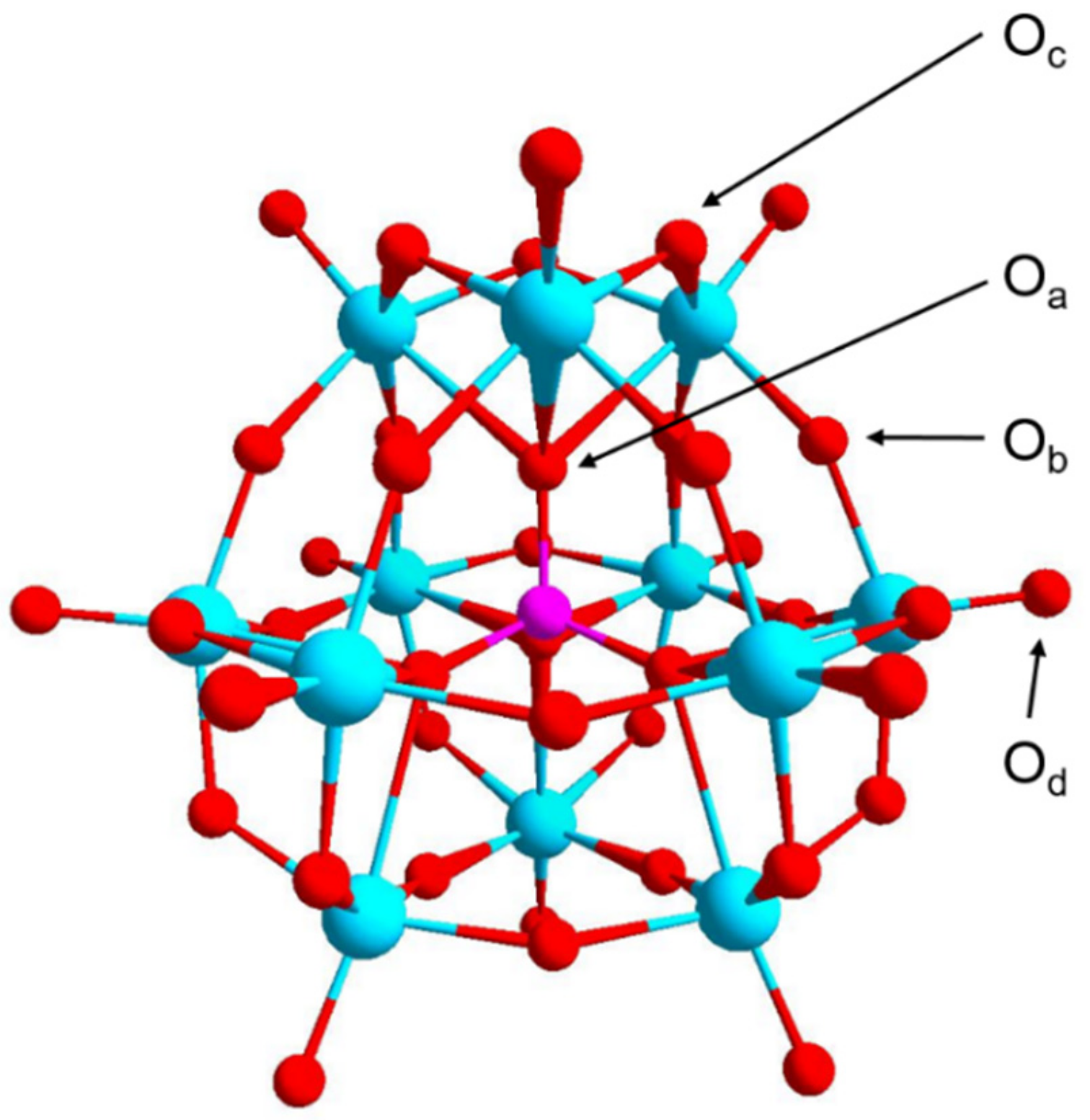
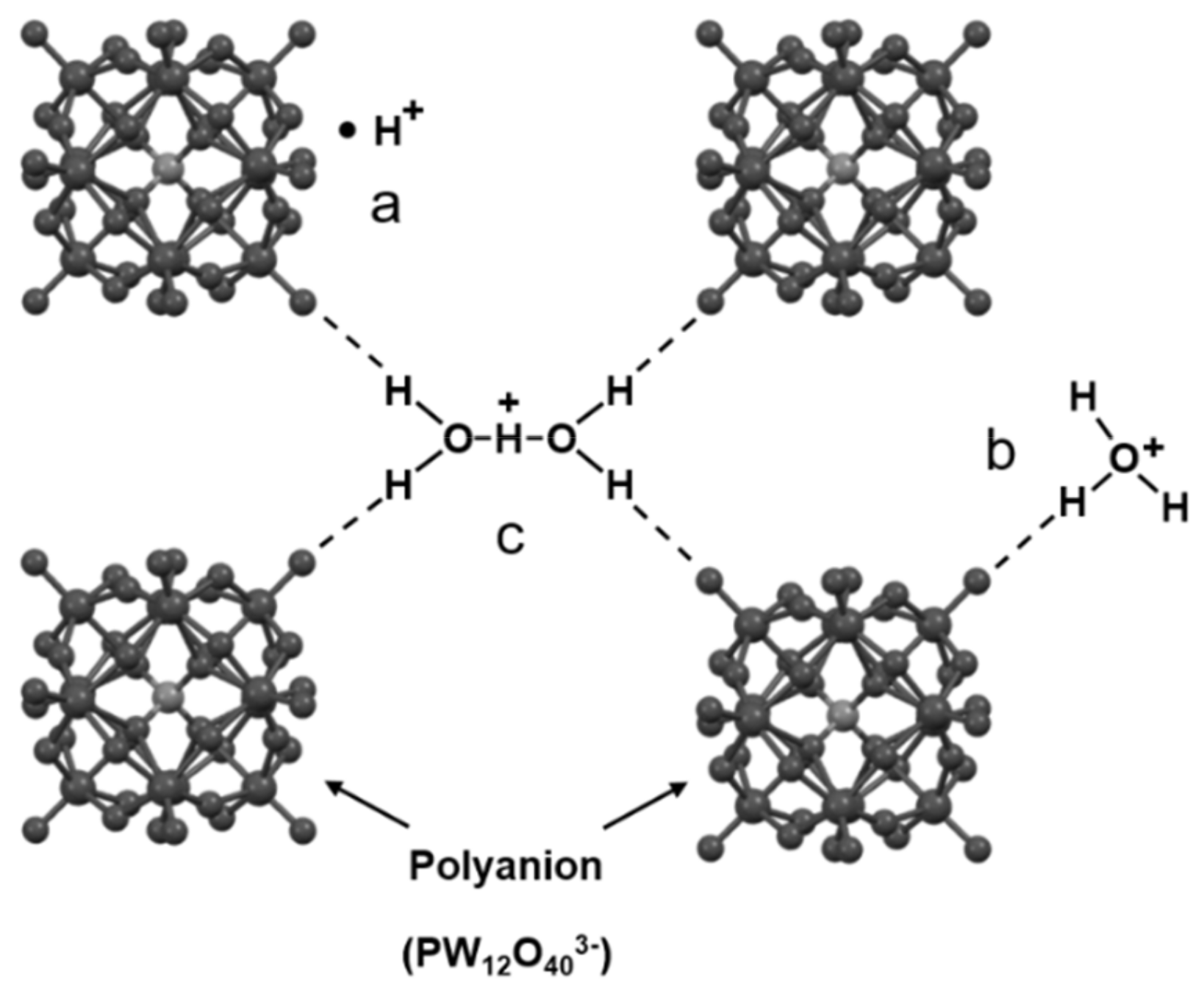
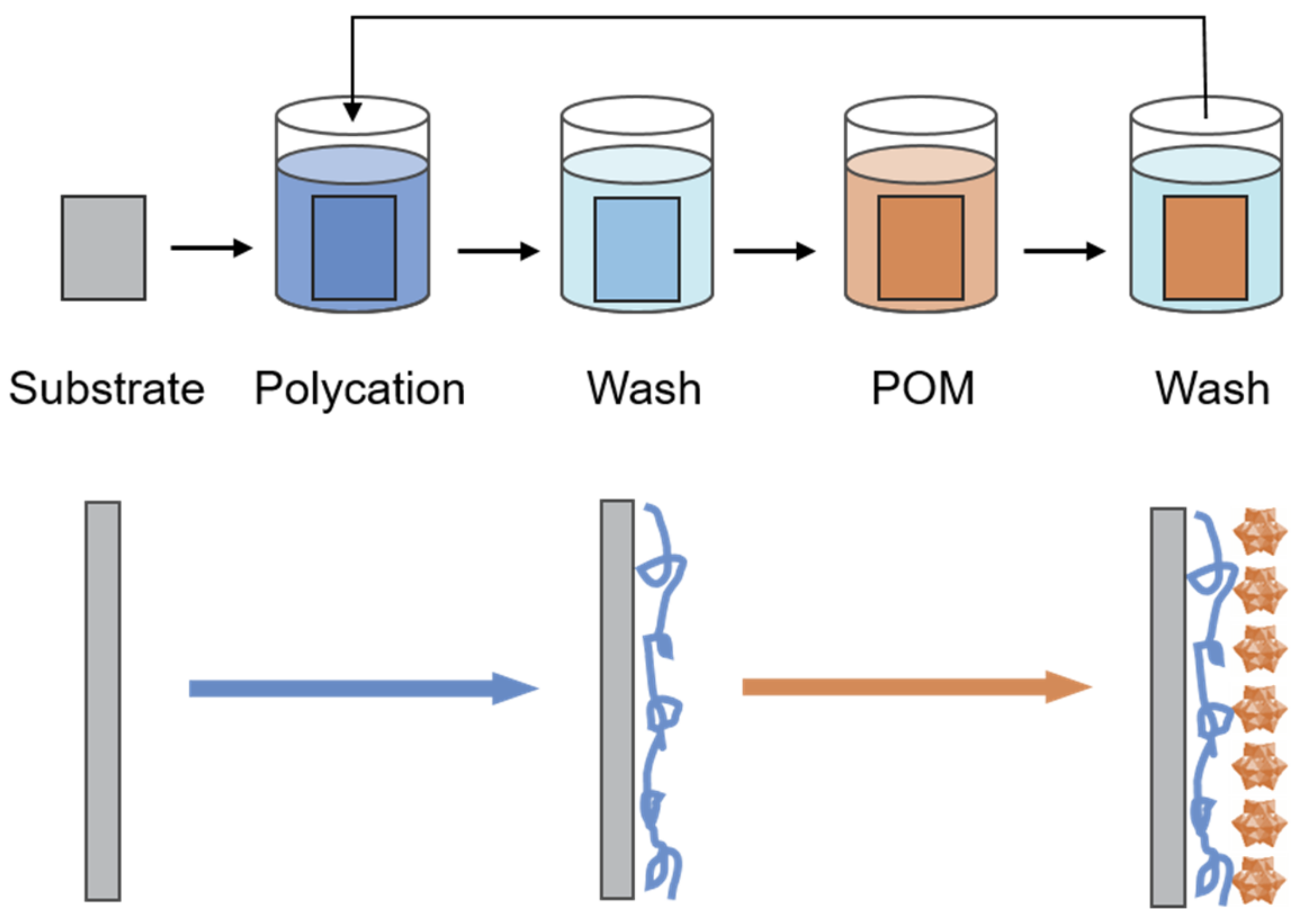
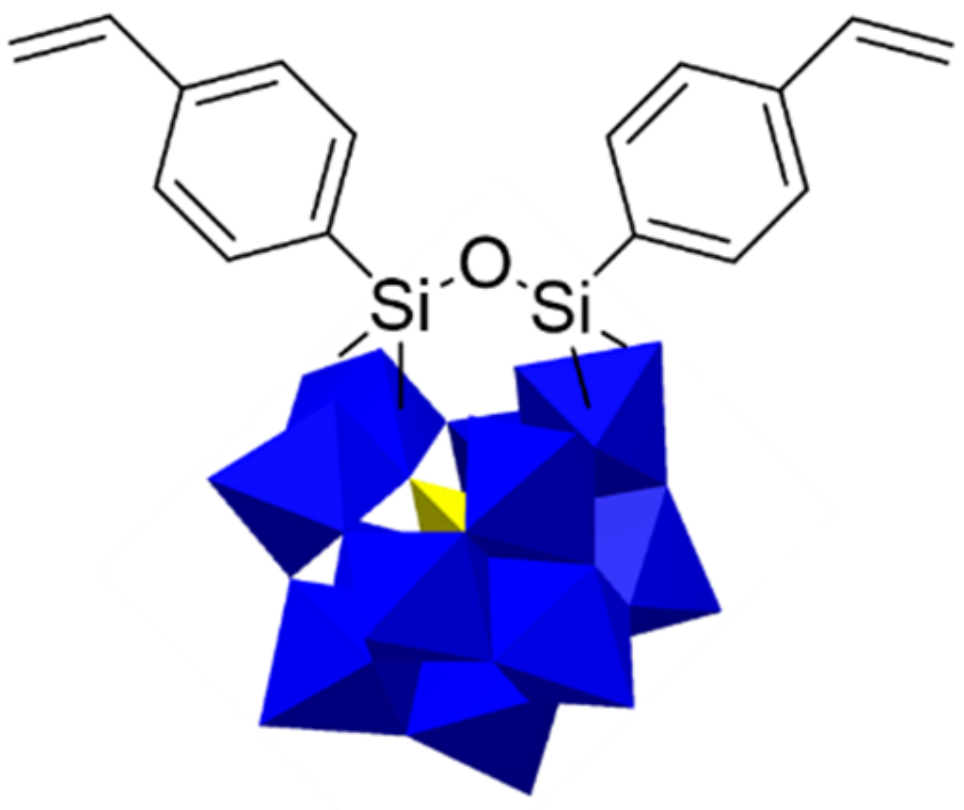

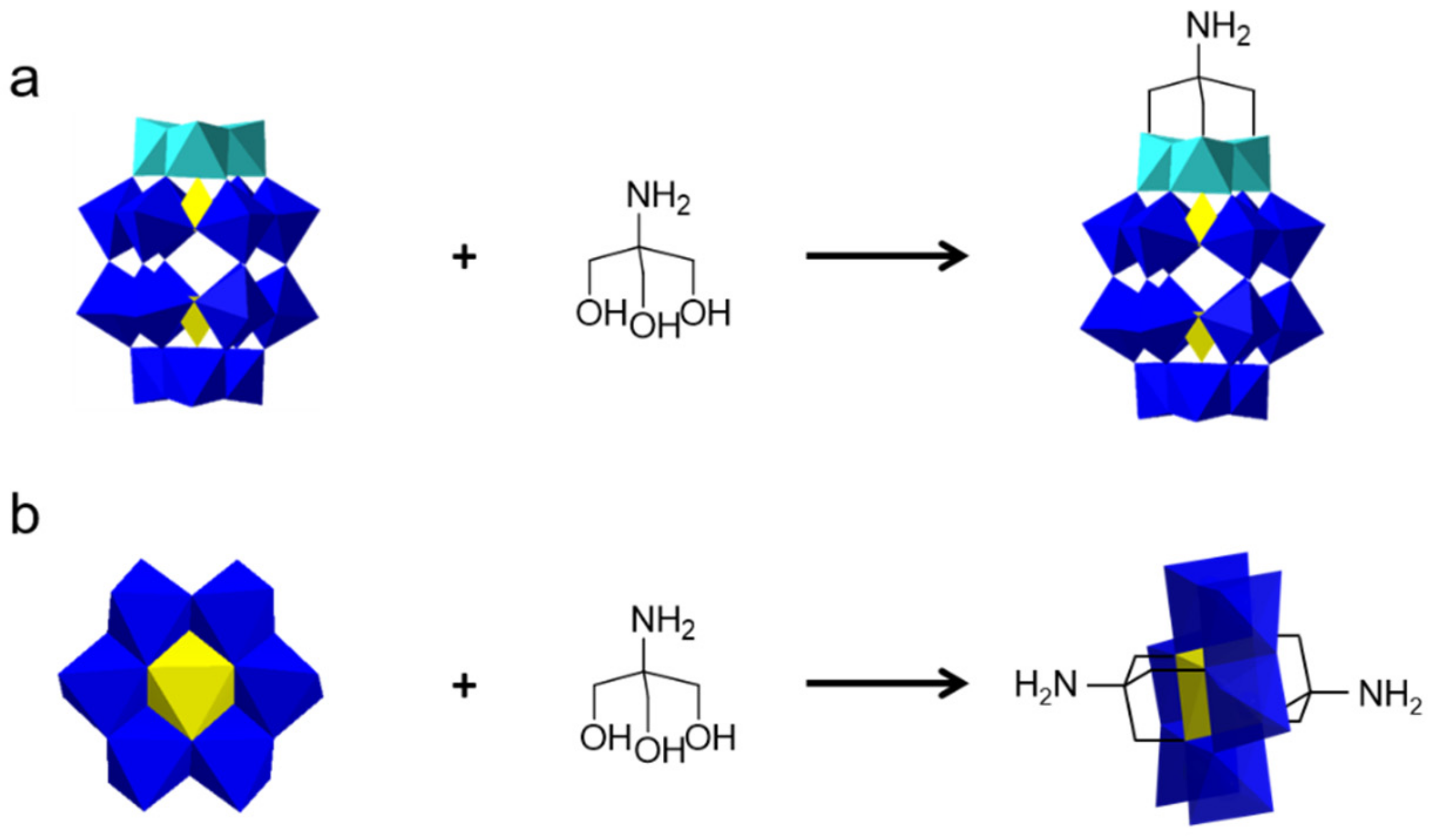
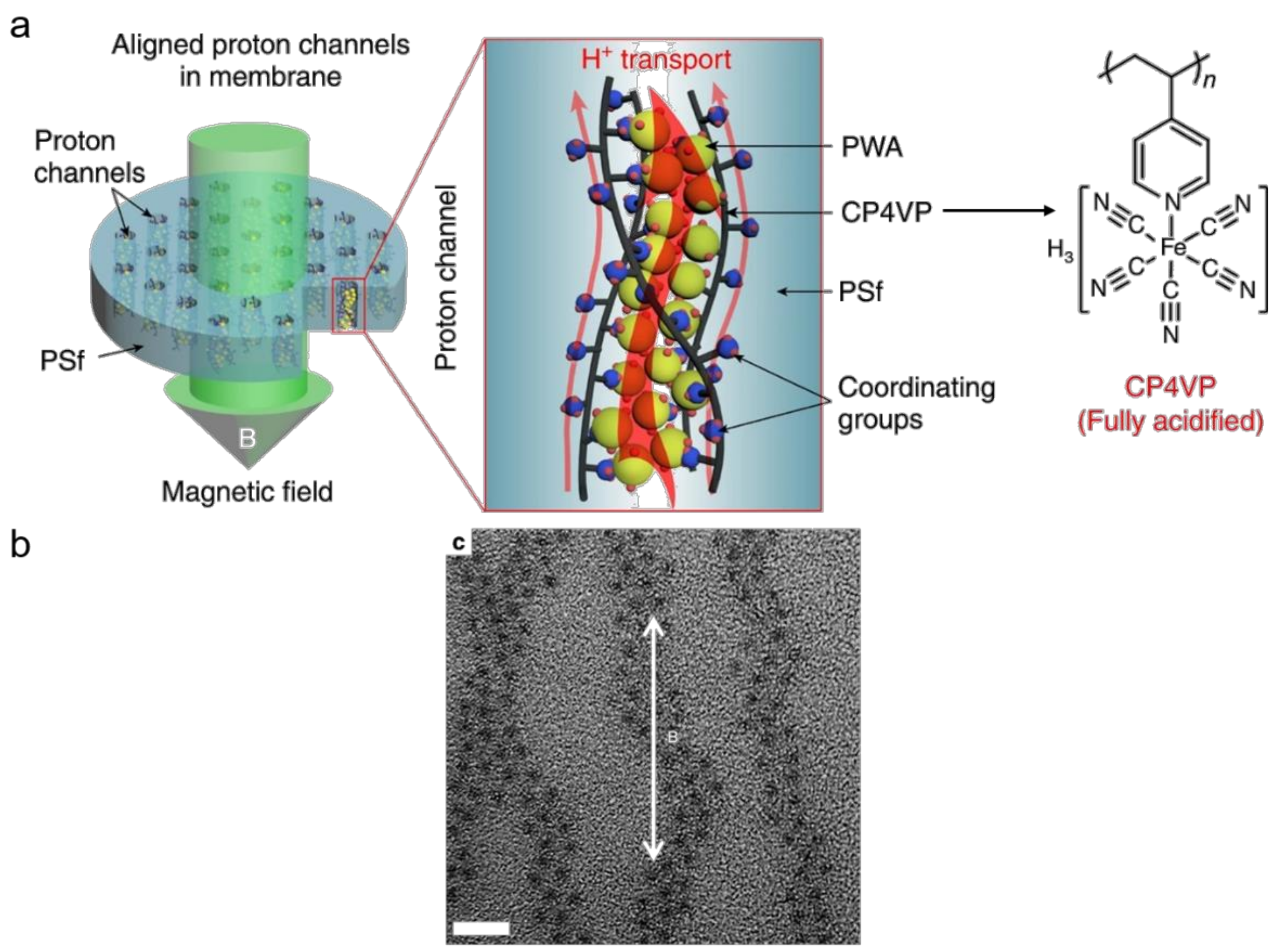


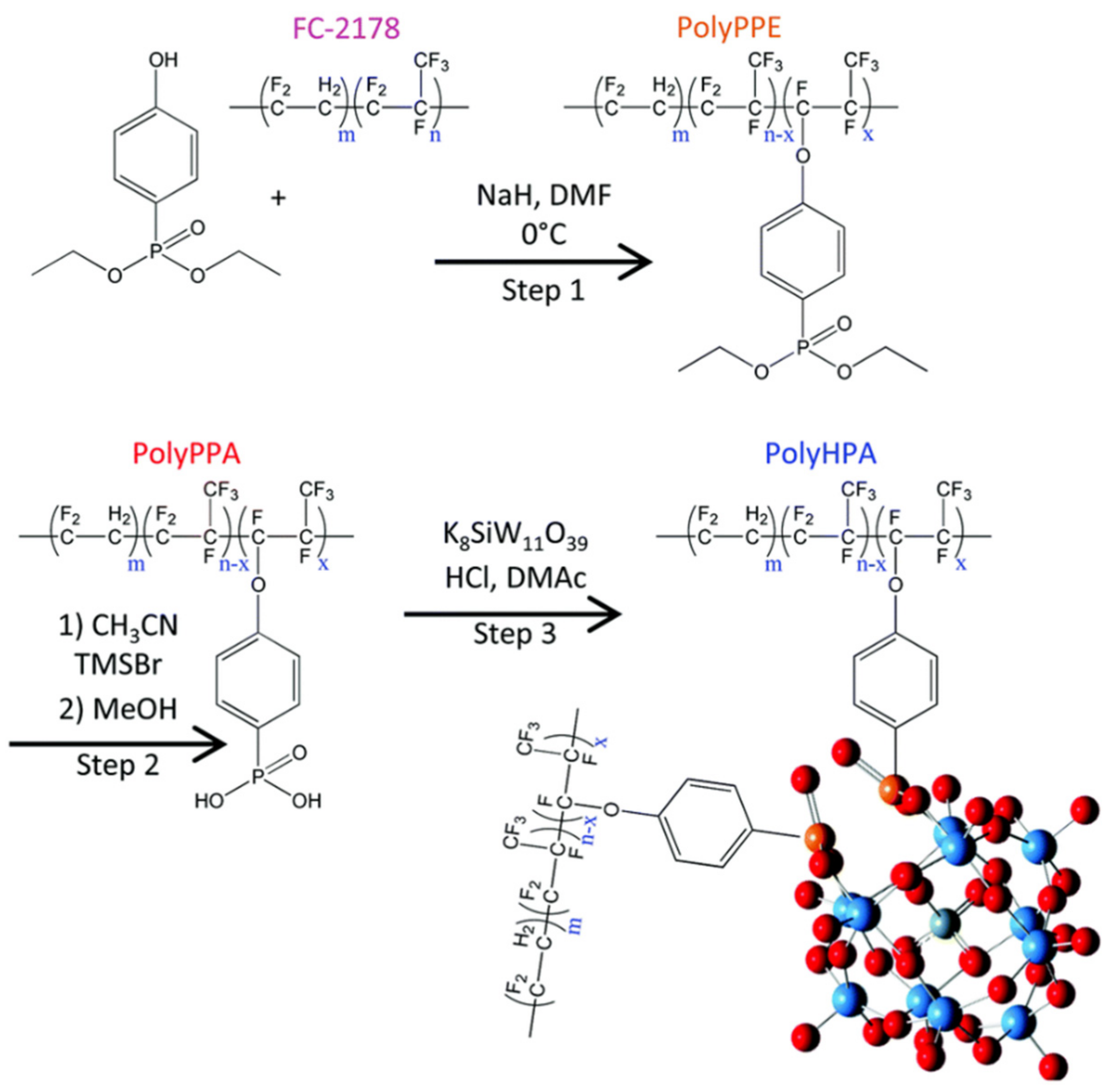
| Compound | Conductivity (S cm−1) at Room Temperature | Reference |
|---|---|---|
| H3PW12O40·29H2O | 0.17 (pellet) | [11] |
| H3PW12O40·28H2O | 0.08 (single crystal) | [43] |
| H3PW12O40·21H2O | 5 × 10−3 (pellet) | [39] |
| 7 × 10−3 (single crystal) | [43] | |
| 1.8 × 10−3 (single crystal) | [44] | |
| aH3PW12O40·14H2O | n.d. | [40] |
| bH3PW12O40·6H2O | n.d. | [40] |
| H3PW12O40 | 1.4 × 10−6 (pellet) | [42] |
| H3PMo12O40·29H2O | 0.18 (pellet) | [11] |
| H3PMo12O40·21H2O | 0.03 (pellet) | [39] |
| H4SiW12O40·28H2O | 0.027 (single crystal) | [43] |
| cH4SiW12O40·6H2O | n.d. | [40] |
© 2019 by the authors. Licensee MDPI, Basel, Switzerland. This article is an open access article distributed under the terms and conditions of the Creative Commons Attribution (CC BY) license (http://creativecommons.org/licenses/by/4.0/).
Share and Cite
Zhai, L.; Li, H. Polyoxometalate–Polymer Hybrid Materials as Proton Exchange Membranes for Fuel Cell Applications. Molecules 2019, 24, 3425. https://doi.org/10.3390/molecules24193425
Zhai L, Li H. Polyoxometalate–Polymer Hybrid Materials as Proton Exchange Membranes for Fuel Cell Applications. Molecules. 2019; 24(19):3425. https://doi.org/10.3390/molecules24193425
Chicago/Turabian StyleZhai, Liang, and Haolong Li. 2019. "Polyoxometalate–Polymer Hybrid Materials as Proton Exchange Membranes for Fuel Cell Applications" Molecules 24, no. 19: 3425. https://doi.org/10.3390/molecules24193425
APA StyleZhai, L., & Li, H. (2019). Polyoxometalate–Polymer Hybrid Materials as Proton Exchange Membranes for Fuel Cell Applications. Molecules, 24(19), 3425. https://doi.org/10.3390/molecules24193425





